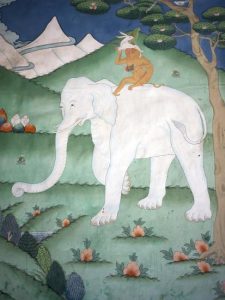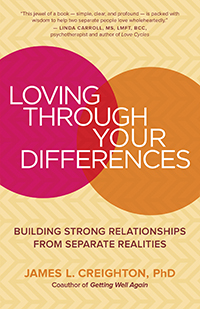The Cube Test
Here’s a fun test I came across to help us to understand more about ourselves and our relationships. “The Cube Test” was created by a psychologist in Japan. The objective is to allow the subconscious to peek through to our awareness to give us insights into our feelings and behavior. It can be really fun, and even eye-opening!
When you go through this exercise, think about how each description makes you feel, not just about how it looks to you. It’s a good idea to do this game with a partner, so you can have your eyes closed. Take turns reading the cues to each other.
You are in a vast desert.
1) Describe the desert. What is it like? What is in the desert? Living or not? How do you feel about being here? Do you like this place? What do you think about it?
There is a cube in the desert.
2) Describe the cube. How big or small is it? What is the cube made of? What is its texture? What is its color? What do you think about it? How do you feel about it? How far away is it from you? Is it transparent? Can you see into the cube?
There is a ladder.
3) Describe the ladder. How big is it? What color is it? What is it made of? What is the distance between the cube and the ladder? Are they touching? What is the relationship between the cube and ladder?
There is a horse.
4) Describe the horse. How much distance is there between the horse and the cube? What color is the horse? What is the horse doing? What impression do you have of the horse? Is it tied up? Is there a saddle?
There is a storm.
5) Describe the storm. How much distance is there between the storm and the cube? Is it a large storm or a small storm? Is it passing through or staying? How do you feel about the storm?
There is a flower, or flowers.
6) How many flowers do you see? Where are they? Where are they in relation to the cube? What color are the flowers? How big or strong are they? How do you feel about the flowers? How do the flowers feel about you?
———————————————
Interpretations of answers:
Remember that your interpretation is what matters the most. Think about what each image represents to you, for you, in your own life.
The Desert:
The desert represents your world view, or your idea of the world you live in. The size represents your knowledge of the world and how vast your worldview is. The conditions of this desert represent how you view the conditions or reality of the world. For example, if there is nothing else alive there, you feel very lonely in the world and perceive the world to be a lonely place. If there are many dead or non-living things, or if it is dull and empty feeling, you are pessimistic and are not feeling enriched by life. On the other hand, if it is full of life and healthy and vibrant, you have an optimistic worldview and feel like the world is a good place to be.
The Cube :
The cube represents yourself. How you think about the cube reflects how you think about yourself. For example, you may think the cube is made of yellow stones. Yellow may give you a feeling of warmth and stone may give you a feeling of strength. Then, it means that you believe that you are a strong and warm person.
The distance between you and the cube reflects your understanding about yourself. If the cube is far away, then it means that you do not feel close to your inner self.
The ratio of the cube to the desert is how you think about yourself in this world. The bigger the ratio, the more grandly you think of yourself and what you’re meant to do. People who see an excessively tiny cube, feel that they are smaller than life. People with a cube that is excessively large, feel as if they are larger than life. A small ratio means that you recognize that you are just one part of this world and there are many other things out there beside you. A large ratio means you thrive on being the center of attention.
A cube with a transparent surface means you tend to let others know how you feel on the inside. You show your inner thoughts, and you are deeply sincere. You know that you are a good person. You feel seen, heard, and understood by others.
A cube made out of water or ice indicates that you let external elements influence you. You are sensitive to social pressure, relationships, and other environmental factors.
A hollow cube can mean that you are concerned with your outside appearance, with more than with what’s going on within. This doesn’t mean that you have nothing to offer on the inside.
A solid cube made out of metal or rock indicates that you have solid integrity. Your personality is so strong that it cannot be bent or influenced by any external force. You are dominant and consistent. However, you are defensive of people trying to see into your inner world. You would rather control what they see or don’t see about you.
The Ladder:
The ladder represents your goals. The length of the ladder shows the scale of your goals – the shorter the ladder, the simpler the goal. The distance between the ladder and the cube determines the focus and effort that you are currently investing in your goals. If your ladder is close to your cube then you are making all effort to achieve and assist your goals. If your ladder is leaning on your cube, you have a big goal to achieve. if your ladder is extending beyond or is in any way over the cube, you may feel your goals are too hard to achieve or you don’t have what you need. If it is under your cube, you are someone who likes to be on top of things but you may keep goals small because of this. The strength of the material of this ladder points to the support you feel you have from others in order to achieve this goal. In some cube tests, the ladder represents friendships.
The Horse:
The horse represents the love partner you are subconsciously seeking. The distance between the horse and the cube represents the closeness you have with your partner. If the horse is facing the cube it shows you want to be the focus of attention in the relationship. If your horse is closer to your ladder it might suggest you want a love partner who supports your goals. If the horse is tied up, then it shows the need to be controlling in a relationship. If the horse has a saddle then you feel secure with them. If the horse is free and not saddled, it means you view your love partner as unpredictable or very independent.
The Storm:
The storm represents the obstacles or problems in your life. If the storm is very intense then your problems are causing havoc in your life. If they encompass the entire desert then it means you might have some ongoing issues, which you think will take a while to resolve. If your storm is light then it means your problems don’t really upset the balance of your world. If it is outside the room it means you see your problems at a distance and they can easily be controlled.
The Flowers:
There is some debate about the interpretation of flowers in relational psychology. The first argument is that the flowers represent your social connections. This could be those you consider to be family or friends. How you feel about the flowers reflects how you feel about the people in your life. The number of the flowers determines your significant connections and how close you are to them, a “bunch” of flowers suggests you have a close group of friends you rely on. A couple suggests you may be close to only very few people. Tons of flowers suggests that you are a social butterfly with many connections or contact, but may not develop a deep relationship with any of them. A row or more of flowers suggests that you have levels of connections, some have stayed and some have gone. The location of the flowers relative to the cube determine how close you are with your people. The color of the flowers represents your current feelings toward them.
The second argument is that the flowers represent children. Some believe the number of flowers you see is either the number of children you will have or the number of children you want to have. The closer the flower is to the cube, the closer you feel to your children or the thought of having children. If your flower is close to the ladder then a goal in life might be to have children. Different colors also represent a variety in children.
Colors:
You may want to look into the meaning of colors more deeply, but here is a quick list of color meanings as they apply to psychology:
Black: Black is the color of authority, elegance, sophistication, mystery, secrecy and seduction. Black can also imply darkness and/or painful emotion. Or rarely, oneness/every thingness.
White: White symbolizes innocence, peace, purity, simplicity, cleanliness. And rarely, nothingness, like a blank slate.
Red: Red represents dominance, power, action, motivation, ambition, leadership, willpower, passion and sexual energy. It is also the color many associate with romantic love.
Pink: Pink represents softness, kindness, friendliness, nurturing, calming, love, naivety.
Orange: Orange represents energy, enthusiasm, excitement, attention seeking, thrill, warmth.
Blue: Blue represents knowledge, openness, royalty, loyalty, tranquility, calm, serenity, security, stability, reliability and sometimes sadness.
Green: Green represents compassion, growth, balance, harmony, equilibrium, prosperity, relaxation, renewal, vitality.
Yellow: Yellow represents optimism, joy, enthusiasm and playfulness, overpowering, sociability, uplifting, cheer, inquisitiveness, original thought.
Purple: Purple represents nobility, luxury, wealth, wisdom, spirituality, frustration, arrogance, creativity.
Brown: Brown shows stability, reliability, solidness, strength, resilience, grounded-ness, safety, stubbornness, isolation, it is also the color of nature, earthiness.
Grey: Grey represents neutrality, calm, balance, detachment, lack of emotion, impartiality, loss, depression.
Silver: Silver represents dignity, graciousness, justice, discerning, unbiasedness, sleekness, ornate, industriousness, quiet wealth, perseverance, patience, emotionality.
Gold: Gold represents success, wealth, winning, achievement, triumph, luxury, prestige, extravagance, pride, charisma and luck.










 Shweta is a
Shweta is a 
 An excerpt from Loving through Your Differences by James L. Creighton, PhD
An excerpt from Loving through Your Differences by James L. Creighton, PhD James L. Creighton, PhD, is the author of Loving through Your Differences and several other books. He has worked with couples and conducted communications training for nearly 50 years around the world. Visit him online at www.jameslcreighton.com.
James L. Creighton, PhD, is the author of Loving through Your Differences and several other books. He has worked with couples and conducted communications training for nearly 50 years around the world. Visit him online at www.jameslcreighton.com. By: Dalma Heyn & Richard Marek, authors of How to Fall in Love
By: Dalma Heyn & Richard Marek, authors of How to Fall in Love ABOUT AUTHORS DALMA HEYN & RICHARD MAREK:
ABOUT AUTHORS DALMA HEYN & RICHARD MAREK: